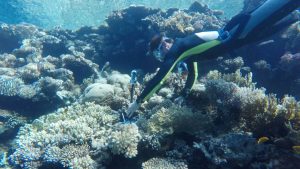Google wants your help in preserving and restoring coral reefs, and has designed a platform to help!

Placing a hydrophone (pic: Google)
Coral reefs are full of sound, meaning you can tell when one has been potentially impacted — those that are quieter are lacking marine life. Through the sounds heard on a reef, scientists can also identify the creatures making each reef their home and this means that they can make calls on how to build those populations and restore the biodiversity of the reef.
This is where you come in.
Google Arts and Culture and marine biologists across the globe have collaborated to start a new citizen science project. They are asking people to listen to underwater recordings of coral reefs in Marine Protected Areas through an online platform. All you need to do is identify sounds made by fish, shrimp and other marine creatures.
How do they get the sounds?
Hydrophones have been placed in 10 reefs around the world, recording 24 hours of sound at a time. This means that there are hundreds of hours of audio to sift through, which is a bit too much for a few scientists, but the general public can make quick work of it. The data from this project will eventually be used to train an AI model designed to listen to the sounds.
How do you get started?
Steve Simpson, a professor of marine biology at the University of Bristol, and Mary Shodipo, a marine ecologist from the Philippines, walk you through the process of identifying different sounds on a reef in the short introductory video. Each recording on the platform is paired with a spectrogram, showing the spectrum of frequencies of the recorded sound waves. You will learn how to identify the difference between creatures with higher and lower frequency sounds, and all you have to do is hit a button when you hear something.
What to listen out for
Just be aware that: “In the background, you’ve got the snapping shrimp, each making little popping sounds that together make the reef crackle.” Don’t confuse those sounds with the lower burps, grunts and gurgles of the fish. Go on, give it a try:
https://artsandculture.google.com/experiment/zgFx1tMqeIZyTw?e










0 Comments